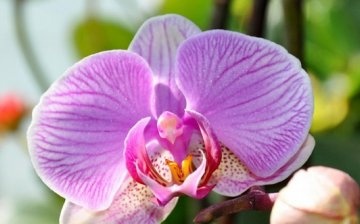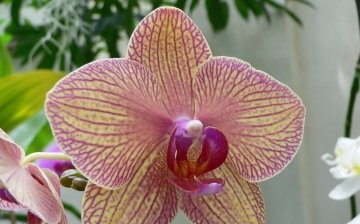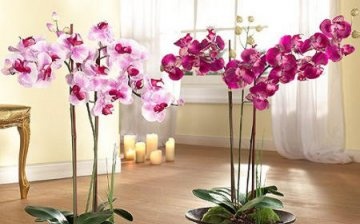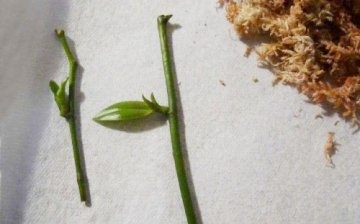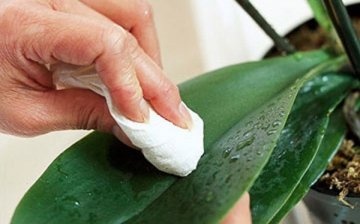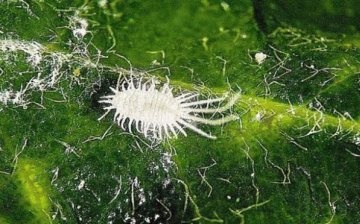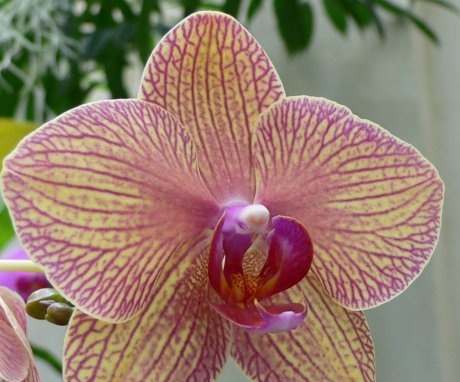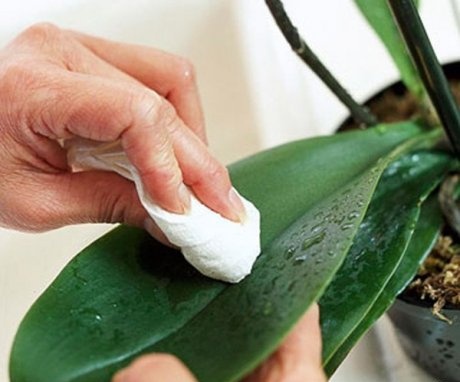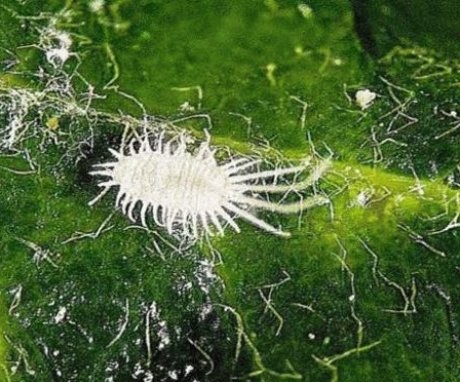Propagation of phalaenopsis by cuttings and growing rules
Orchid, which until recently was a flower exclusively overseas, outlandish, confidently entered our life. Now in many apartments, offices, offices, you can see her graceful flowers. The orchid differs significantly from the plants we are accustomed to, both in reproduction methods and in cultivation. Is it possible to get young orchids at home?
Content:
- Phalaenopsis: description
- Growing conditions
- Propagation by cuttings
- Houseplant care
- Pests and diseases
Phalaenopsis: description
Phalaenopsis Is one of the most numerous and widespread genera of the orchid family. This is an evergreen plant, relatively unpretentious. It has about 50 species. About 500 hybrids have been created on their basis. The homeland of Phalaenopsis is Australia, Malaysia, southern China. At home, in the tropics, phalaenopsis grows wild on tree trunks.
Phalaenopsis belongs to monopodial orchids. It differs from other types of orchids in its short, upright stem and fleshy, hard, shiny leaves, collected in a rosette. Phalaenopsis do not form rhizomes and pseudobulbs. They are held by trees and rocks by aerial roots. He, like all monopodial orchids, has only one growth point - at the top of the plant. Phalaenopsis flowers are similar to large butterflies. Even their name speaks about it.
Phalaenopsis means "like a moth".
They are composed of petals and lips. They differ slightly in shape, and the variety of colors is amazing. These are white, yellow, green, pink, red, lilac and other colors and their shades. Many flowers are painted with specks, veins, spots of different sizes. The lip is often painted with a contrasting color compared to the main background.
One flower can produce inflorescences at a time, on which up to hundreds of flowers are placed. Each of them can bloom for up to 4 months. Phalaenopsis can bloom up to three times a year. There are two varieties of this plant. Common ones reach 1 m, miniature ones reach only 30 cm. The smell is pleasant, sweetish.
Growing conditions
Phalaenopsis is a relatively unpretentious plant. But there are a number of prerequisites. Under natural conditions, phalaenopsis grows at a humidity of 60%. It is difficult to provide such an indicator at home. But in the wild, the roots of the plant are open, and at home they are hidden in the substrate. Therefore, the air humidity values can be reduced. But all the same, they should not be lower than 30%. If it is even lower, then the period can be significantly reduced flowering or the plant will get sick.
How to ensure such humidity? The first thing that comes to mind is to regularly spray the flower. But this must be done very carefully so as not to get on the core of the outlet (this can lead to rotting of parts of the plant). Water is taken from snow or rain so that there are no white spots on the leaves. It is necessary to install a deep tray with water under the flowerpot. Gravel or expanded clay can be laid at the bottom. Water evaporates under the influence of the temperature in the room, increasing the humidity of the air. If the moisture is sufficient, the green parts of the aerial roots are quite long.But during the dormant period, after active flowering, the roots acquire a uniform color.
An important condition for the successful cultivation of phalaenopsis is correct and sufficient lighting.
The growing conditions of the plant in the wild are taken into account. Phalaenopsis does not require a lot of light. Moreover, he does not like direct sunlight. It is good to place it on the western or eastern parts of an apartment or room.
In winter, Phalaenopsis needs 12-15 hours of lighting. After the New Year, it becomes real. But in the fall, natural light is not enough. Therefore, it is necessary to supplement the illumination of the plants using fluorescent lamps. If this is not done in time, young flower stalks will dry out. In order for the plant to receive the amount of light necessary for growth and development all year round, it must be installed on the west or south side in autumn, and transferred to the east in March. In summer, phalaenopsis reacts to insufficient lighting by reducing the size of the leaves.
Propagation by cuttings
Monopodial orchids are much more difficult to propagate than sympodial orchids. After all, they have significantly fewer growth points. When breeding phalaenopsis, you must follow these rules:
- All tools must be disinfected before work.
- All sections are sprinkled with crushed coal. You can take the activated one and grind it.
- Roots must be handled very carefully due to their excessive fragility.
- The substrate in which the new plant is planted is moistened with soft water.
- After transplants the plant is placed in a warm place, protected from sunlight.
- For a month it is not watered, but sprayed.
Phalaenopsis reproduces:
- kids
- seedlings in a flask
- dividing the bush
- cuttings
From these methods at home, seed reproduction is eliminated. They do not have a supply of nutrients, so only specialists can grow a new plant from them. For this, a special medium is used, and the process itself from sowing to flowering takes several years.
Experts who are seriously involved in the reproduction of phalaenopsis consider reproduction cuttings basic for this plant:
- Reproduction is possible in several ways. They differ in the length of the stem and the number of dormant buds on it. It should be borne in mind that the strongest buds are those that were on the peduncle below the others.
- Cut off a lateral shoot or a faded peduncle. Cut it into pieces so that the pieces are 4 cm long, and in the center of each cutting there is a dormant bud. The cut points are immediately sprinkled with charcoal powder or powder.
- You can cut the shoot into cuttings so that there are two nodes with axillary buds. In this case, the length of each of them must be at least 10 cm.
- Then the cuttings are laid on a moistened surface and a greenhouse is arranged over them. You can make it out of polyethylene. Sphagnum moss or moistened sand is taken as soil for germination. In the greenhouse, you need to maintain constant humidity, and the temperature should constantly be around 28 degrees.
By the same principle, phalaenopsis can be propagated by layering, having engrafted them in a pot installed next to it. After the plant has taken root, it is cut off and grown separately.
Houseplant care
For phalaenopsis, two types of temperatures are monitored: tolerable, at which the plant can survive, but will not develop, and useful. Phalaenopsis feels pretty well at temperatures from 16 to 25 degrees. The ideal temperature is 18 to 22 degrees. And for the formation of peduncles, you need to maintain it at 16 degrees. This is a dormant period. It can grow at 23-35 degrees, but it will not bloom so actively.
The temperature in the room must not be allowed to fall below 12 degrees or rise above 45. In the first case, the buds will fall off, the leaves lose their elasticity, the plant will get sick and die.If it is very hot, the leaves of the plant will burn.
Phalaenopsis is poured with soft, cold water.
In order to moisturize the plant by immersion, you need to take filtered water, heat it up and lower the plant there for half an hour. In this case, the pot should be half immersed.
Phalaenopsis is most often grown in transparent pots. But not glass, but plastic. There should be a large number of holes in its bottom and walls. If you cannot find such a pot, you can do them with the help of auxiliary means. Growing in transparent pots is convenient because you can always control the condition of the roots and substrate. The roots do not adhere to the walls of such a pot, therefore, during transplants they are practically not injured. The size of the pot is important for successful cultivation.
If it is too large, taken "with a margin", the substrate does not have time to dry, which can cause the roots to rot. But a small pot also does not reflect well on the well-being of phalaenopsis. The roots are injured, there is no way to provide the plant with a sufficient amount of nutrients, the process of photosynthesis is disrupted. The growth of a large number of aerial roots signals the owners that it is time to transplant the plant. The pot is already too small for him.
For growing phalaenopsis, a substrate is prepared, which consists of the main components:
- Bark of trees.
- Charcoal.
- Perlite.
- Sphagnum moss.
The proportions depend on the growing conditions. If the air in the room is dry, then more moss is needed, up to a third of the composition. If the humidity is high, then its amount can be minimized. The substrate must be loose enough. It is easiest to buy it in specialized stores. Fertilize during the period of active growth, every 3 weeks, with a complex fertilizer for orchids.
Pests and diseases
Pests:
- thrips
- aphid
- mealybug
- scabbards.
For treatment, the affected areas are washed with warm water. It should be flowing to wash off as many pests and eggs as possible. The site is then dried and treated with pesticides.
The main phalaenopsis disease is brown leaf spot.
If the first signs appear, the damaged areas are urgently removed. Then they are treated with antibacterial drugs. The tools used to process the plant are disinfected with alcohol or boiled water. When infected with a viral disease, the plant is isolated. If the diagnosis is confirmed, it is removed.
More information can be found in the video:



